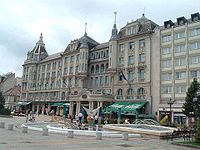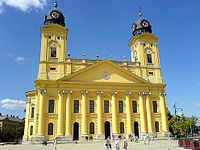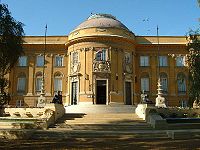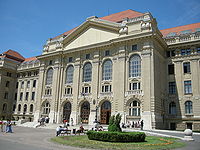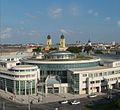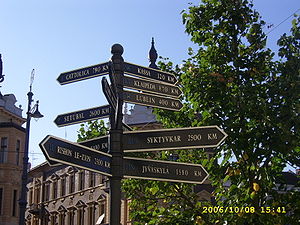- Debrecen
-
Debrecen 
Coat of armsNickname(s): "The Calvinist Rome" Location of Debrecen Coordinates: 47°31′48″N 21°38′21″E / 47.52997°N 21.63916°ECoordinates: 47°31′48″N 21°38′21″E / 47.52997°N 21.63916°E Country  Hungary
HungaryCounty Hajdú-Bihar Government – Mayor Lajos Kósa (Fidesz) Area – Total 461.25 km2 (178.1 sq mi) Population (2011) – Total 208,016 
– Density 442.53/km2 (1,146.1/sq mi) Time zone CET (UTC1) – Summer (DST) CEST (UTC+2) Postal code 4000 Area code(s) 52 Debrecen (Hungarian pronunciation: [ˈdɛbrɛtsɛn] (
 listen), known by alternative names),[1] is the second largest city in Hungary after Budapest. Debrecen is the regional centre of the Northern Great Plain region and the seat of Hajdú-Bihar county.
listen), known by alternative names),[1] is the second largest city in Hungary after Budapest. Debrecen is the regional centre of the Northern Great Plain region and the seat of Hajdú-Bihar county.Contents
Name
The city was first mentioned by the name "Debrezun" in 1235. Theories say the name is of Cuman origin. In other languages the name of the city is the following : German Debrezin, Serbian Debr(e)cin Slovak Debrecín, Romanian Debreţin.
Climate
Climate data for Debrecen Month Jan Feb Mar Apr May Jun Jul Aug Sep Oct Nov Dec Year Average high °C (°F) 0.6
(33.1)4.1
(39.4)10.4
(50.7)16.6
(61.9)21.7
(71.1)24.6
(76.3)26.5
(79.7)26.1
(79.0)22.4
(72.3)16.5
(61.7)8.5
(47.3)2.6
(36.7)15.05
(59.09)Average low °C (°F) −5.5
(22.1)−3
(26.6)0.6
(33.1)5.4
(41.7)10.1
(50.2)13.4
(56.1)14.4
(57.9)13.7
(56.7)10.3
(50.5)5.3
(41.5)1.3
(34.3)−2.8
(27.0)5.27
(41.48)Precipitation mm (inches) 37
(1.46)30
(1.18)34
(1.34)42
(1.65)59
(2.32)80
(3.15)65
(2.56)61
(2.4)38
(1.5)31
(1.22)45
(1.77)44
(1.73)566
(22.28)Avg. precipitation days 8 6 7 8 9 10 8 7 5 5 8 8 89 Sunshine hours 55.8 81.2 145.7 192.0 238.7 249.0 282.1 260.4 201 161.2 69.0 46.5 1,982.6 Source: HKO Location and transport infrastructure
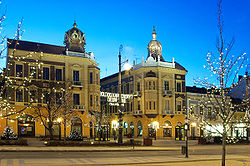 Kossuth Square
Kossuth Square
Debrecen is located on the Great Hungarian Plain, 220 km (137 mi) east of Budapest. Situated nearby is the Hortobágy, a national park within Hungary .
The city used to be somewhat isolated from Budapest, Hungary's main transport hub. However, the completion of the motorway M35 means Budapest can now be reached in under two hours. Debrecen Airport (the second largest in Hungary) has recently undergone modernisation in order to be able to handle more international flights, although almost all flights to and from Hungary still use Budapest's Ferihegy Airport. There have also been improvements to some parts of the railway between the capital and Debrecen as part of Hungary's mainly EU-funded National Development Plan for 2004 to 2006.
Debrecen's proximity to Ukraine and Romania enables it to develop as an important trade centre and transport hub for the wider international region.
Local transport in the city consists of buses, trolleybuses and trams. It is provided by the DKV (Debreceni Közlekedési Vállalat). Nearby towns and villages are linked to the city by Hajdú Volán bus services.
History
Before Hungarians founded Hungary a number of different tribes lived in the area. The town came into existence after some of the small villages of the area (Boldogasszonyfalva, Szentlászlófalva and Debreczun) merged. It experienced rapid development after the middle of the 13th century.
In 1361 Louis I of Hungary granted the citizens of Debrecen the right to choose the town's judge and council. This provided some opportunities for self-government for the town. By the early 16th century Debrecen was an important market town. King Sigismund, Holy Roman Emperor, as part of a treaty with Serbian ruler Stefan Lazarević, gave him the opportunity to rule Debrecen in September of 1411. A year after Lazarević's death in 1426, his role was taken over by his successor, Đurađ Branković. Between 1450 and 1507, it was a domain of the Hunyadi family.
During the Ottoman period, being close to the border and having no castle or city walls, Debrecen often found itself in difficult situations and the town was saved only by the diplomatic skills of its leaders. Sometimes the town was protected by the Ottoman empire, sometimes by the Catholic European rulers or by Francis II Rákóczi, prince of Transylvania. This led the town's citizens to be open-minded and Debrecen embraced the Protestant Reformation quite early, earning the moniker "Calvinist Rome". At this period the inhabitants of the town were mainly Hungarian Calvinists. Debrecen became sanjak between 1541 and 1693 and orderly bounded to eyalets of Budin (1541–1596), Eğri (1596–1660) and Varat (1660–1693) as "Debreçin".
In 1693 Leopold I, Holy Roman Emperor elevated Debrecen to free royal town status. In 1715, the Roman Catholic Church returned to Debrecen, and the town gave them a place to build a church, so the Piarist monks could build the St. Anna Cathedral. By this time the town was an important cultural, commercial and agricultural centre, and many future scholars and poets attended its Protestant College (a predecessor of today's University of Debrecen and also of Debrecen Reformed Theological University).
In 1849 Debrecen was the capital of Hungary for a short time when the Hungarian revolutionary government fled there from Pest-Buda (modern-day Budapest.) In April 1849, the dethronization of Habsburgs (neglected after the fall of the revolution) and the independence of Hungary was proclaimed here by Lajos Kossuth at the Great (Calvinist) Church (Nagytemplom in Hungarian.) The last battle of the war of independence was also close to Debrecen. The Russians, allied to Habsburgs, defeated the Hungarian army close to the western part of the town.
After the war, Debrecen slowly began to prosper again. In 1857 the railway line between Budapest and Debrecen was completed, and Debrecen soon became a railway junction. New schools, hospitals, churches, factories, mills were built, banks and insurance companies settled in the city. The appearance of the city began to improve too: with new, taller buildings, parks and beautiful villas it no longer resembled a provincial town and began to look like a modern city. In 1884 Debrecen became the first Hungarian city to have a steam tramway.
After World War I, Hungary lost a considerable portion of its eastern territory to Romania, and Debrecen once again became situated close to the border of the country. It was occupied by the Romanian army for a short time in 1919. Tourism provided a way for the city to begin to prosper again. Many buildings (among them an indoor swimming pool and Hungary's first stadium) were built in the central park, the Nagyerdő ("Big Forest"), providing recreational facilities. The building of the university was completed. Hortobágy, a large pasture owned by the city, became a tourist attraction.
During World War II, Debrecen was almost completely destroyed, 70% of the buildings suffered damage, 50% of them were completely destroyed. A major battle involving combined arms, including several hundred tanks (Battle of Debrecen), occurred near the city in October 1944. After 1944 the reconstruction began and Debrecen became the capital of Hungary for a short time once again. The citizens began to rebuild their city, trying to restore its pre-war status, but the new, Communist government of Hungary had other plans. The institutions and estates of the city were taken into public ownership, private property was taken away. This forced change of the old system brought new losses to Debrecen; half of its area was annexed to nearby towns, and the city also lost its rights over Hortobágy. In 1952 two new villages – Ebes and Nagyhegyes – were formed from former parts of Debrecen, while in 1981 the nearby village Józsa was annexed to the city. The newly built blocks of flats provided housing for those who lost their homes during the war. In the following decades Debrecen was the third largest city of Hungary (behind Budapest and Miskolc), and became the second largest in the 1990s when the population of Miskolc decreased.
Jews of Debrecen
Jews were first allowed to settle in Debrecen until 1814, with an initial population count of 118 men within 4 years. Only 20 years later were they allowed to purchase land and homes. By 1919 they were 10% of the population (with over 10,000 community members listed) and owning almost half of the large properties in and around the town.[2]
The Hungarian antisemitic laws of 1938 caused many businesses to close, and in 1939 many Jews were drafted into forced labor groups and sent to the Ukraine, where many died in minefields.[3]
In 1940 the Germans estimated that 12,000 Jews were left in the town. In 1941 Jews of Galician and Polish origin were expelled, reducing the number of Jews to 9142. In 1942 more Jews were drafted into the Hungarian forced labor groups and sent to the Ukraine.
German forces entered the city in March 20, 1944 (Two and a half weeks before Passover) ordering a Judenrat (Jewish Council) headed by Rabbi Pal (Meir) Weisz, and a Jewish police squad was formed, headed by former army captain Bela Lusztbaum. On March 30 (a week before Passover) the Jews were ordered to wear the Yellow star of David. Jewish cars were confiscated and phone lines cut. During the Passover week, many Jewish dignitaries were taken to a nearby prison camp, eventually reaching the number of 300 prisoners. A week later all Jewish stores were closed, and a public book-burning of Jewish books was presided by the antisemitic newspaper editor Mihaly Kalosvari Borska.
An order to erect a ghetto was issued on April 28, in the name of the town mayor Sandor Kolscey, who opposed the act, and was ousted by the Germans. Jews were forced to build the Ghetto walls, finishing it within less than a month on May 15.
On June 7, all movement in or out of the Ghetto was prohibited and a week later all Debrecen Jews were deported to the nearby Serly brickyards, and stripped of their belongings, joining Jews from other areas.[4]
10 families of prominent Jews, including those of Rabbi Weisz and orthodox chief Rabbi Strasser, along with the heads of the Zionist (non orthodox) movement joined the Kasztner train. (According to some sources, the Strasshoff camps where filled with Jews for negotiations in case the Germans could receive something for releasing these Jews, among them 6841 from Debrecen.) 298 of these Debrecen Jews where shot by the SS in Bavaria, after being told they would reach Theresienstadt. Some young Debrecen Jews escaped the town, lead by the highschool principal Adoniyahu Billitzer and reached Budapest, joining resistance movements and partisans.[5]
Most of the remaining Debrecen Jews where deported to Auschwitz, reaching there on July 3, 1944. Debrecen was liberated by the Soviet Army on 20 October 1944. Some 4000 Jews of Debrecen and its surroundings survived the war, creating a community of 4640 in 1946 - the largest in the region. About 400 of those moved to Israel, and many others moved to the west by 1970, with 1200 Jews left in the town, using two synagogues, one of them established prior to WWI.[6]
Population
Historical populations Year Pop. ±% 1870 45,132 — 1880 50,320 +11.5% 1890 56,246 +11.8% 1900 73,878 +31.3% 1910 90,764 +22.9% 1920 101,543 +11.9% 1930 116,013 +14.3% 1941 124,148 +7.0% 1949 115,399 −7.0% 1960 134,930 +16.9% 1970 167,860 +24.4% 1980 198,195 +18.1% 1990 212,235 +7.1% 2000 203,648 −4.0% 2010 207,270 +1.8% 2011 208,016 +0.4% Ethnic groups (2001 census)
- Magyars - 94.7%
- Roma - 0.5%
- Others - 0.8%
- No answer - 4%
Religions [7]
- Calvinist - 38.7%
- Roman Catholic - 15.4%
- Greek Catholic - 8.2%
- Lutheran - 0.5%
- Others - 1.5%
- Atheist - 24.8%
- No answer - 10.9%
Culture
The main building of the University of Debrecen.
Chiefly thanks to the reformation and the prestigious Calvinist College, founded in 1538, Debrecen has been the intellectual and cultural centre of the surrounding area since the 16th century. Over the centuries the College was transformed into a University and its intellectual life developed a sphere of influence between Eger and Oradea (Hu: Nagyvárad, now in Romania). In 1949/1950 several departments of the University were shut down, due to Communist takeover, with many students and teachers being expelled. The University of Debrecen, as it is now called is still widely recognized work of architecture (mostly thanks to its main building). The university has many departments and is a major research facility in Europe.[8]
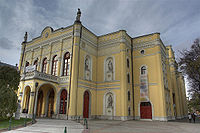 Csokonai Theatre
Csokonai Theatre
In the second half of the 19th century, the Debrecen press attracted several notable figures to the city. Endre Ady, Gyula Krúdy and Árpád Tóth all began their journalistic careers in Debrecen. Prominent literary figures from the city have included Magda Szabó, and Gábor Oláh. One of Hungary's best known poets, Mihály Csokonai Vitéz, was born and lived in the city. The city's theatre, built in 1865, was named in his honour in 1916, but can trace its roots back to the National Theatre Company founded in Debrecen in 1789, which at first gave performances in the carthouse of an inn. Celebrated actress Lujza Blaha is amongst those to have performed there.[9]
Debrecen has a flourishing music scene, and is home to Tankcsapda, one of Hungary's most popular and successful rock bands. There is also a rock school in the city offer training and mentoring to young musicians. Classic media in the city include the newspaper Napló, two TV channels, a range of local radio stations and several companies and associations producing media material.
Debrecen is the site of an important choral competition, the Bela Bartok International Choir Competition, and is a member city of the European Grand Prix for Choral Singing. Every August the city plays host to a flower festival.
Sports
The city has a famous football club, Debreceni VSC, which currently has the best recent record in Hungary. Its results include winning the national championship in the consecutive seasons of 2004/2005, 2005/2006, 2006/2007, 2008/2009 and 2009/2010. The stadium, which seats more than 10,000, is on Oláh Gábor street, in the City Park (Nagyerdő). The home color of the team is red, while the away color is white. There are currently plans for a large new stadium to be built in the city, which will serve as Debrecen VSC's home ground.
The city has hosted several international sporting events in recent years, such as the second World Youth Championships in Athletics in July 2001 and the first IAAF World Road Running Championships in October 2006. The 2007 European SC Swimming Championships and World Artistic Gymnastics Championships of 2002 also took place in Debrecen. Most recently, the city hosted the 19th FAI World Hot Air Balloon Championship in October 2010.
The city was an official applicant to host the inaugural Youth Olympic Games in 2010, but lost out to Singapore.
Gallery
-
Nagyerdő (Greatwood) City Park, the first Nature Reserve in Hungary
-
Interior of the Great Church
Main sights
- Protestant Great Church (Nagytemplom)
- City Park (Nagyerdő) and spa
- Déri Museum (art collection including paintings of Mihály Munkácsy; also has a collection of Ancient Egyptian artifacts)
- Flower Carnival of Debrecen held on 20 August every year
Famous people
Born in Debrecen
- Ferenc Barnás (born 1959), novelist
- Zsolt Baumgartner (born 1981), first Hungarian Formula One driver
- Mihály Fazekas (1766–1828), writer
- Mihály Flaskay (born 1982), breaststroke swimmer
- Nóra Görbe, (born 1956), actress, singer and pop icon
- Dr. George Karpati (1934–2009), physician, neurologist, surgeon, teacher, author
- Rivka Keren (born 1946), Israeli writer
- Orsi Kocsis (born 1984), fashion, glamour and art nude model
- Imre Lakatos (1922–1974), philosopher of mathematics and of science
- Paul László (1900–1993), architect
- Kocsár Miklós (born 1933), composer
- Magda Szabó (1917–2007), writer
- Mihály Csokonai Vitéz (1773–1805) poet
- Chaim Michael Dov Weissmandl (1903–1957), rabbi and Holocaust activist
- Meshulam Gross (1863–1947), Hungarian-American entrepreneur
Lived in Debrecen
- Endre Ady (1877–1919), poet
- Julia Bathory (1901–2000), glass artist
- Géza Hofi, (1936–2002) stand-up comedian
- Sándor Szalay (physicist) (1909–1987), physicist, founder of ATOMKI
- Árpád Tóth (1886–1928), poet
Twin towns - sister cities
See also: List of twin towns and sister cities in HungaryDebrecen is twinned with:
 Patras, Greece[10]
Patras, Greece[10] Rishon LeZion, Israel
Rishon LeZion, Israel Setúbal, Portugal
Setúbal, Portugal Saint Petersburg, Russia
Saint Petersburg, Russia Shumen, Bulgaria
Shumen, Bulgaria Syktyvkar, Russia[11]
Syktyvkar, Russia[11] Taitung City, Republic of China (Taiwan)
Taitung City, Republic of China (Taiwan)
See also
Debrecen cuisine
- Debrecener – a pork sausage
Notes and references
- ^ . Alternative spellings used in English include Debreczen and Debrcczin.
- ^ Debrecen Kehilla book page 12
- ^ pp 13, 14
- ^ The Encyclopedia of Jewish Life Before and During the Holocaust On the Hyduboszormeny jail camp
- ^ pp 43, 52 and more
- ^ Shtetlinks on Debrecen
- ^ "2001 Census". http://www.nepszamlalas.hu/eng/volumes/06/09/tabeng/3/load01_10_0-2.html. Retrieved 03-07-2010.
- ^ https://www.unideb.hu/portal/en/node/19
- ^ http://csokonaiszinhaz.hu/index.php?option=com_content&view=article&id=185%3Aa-szinhaz&catid=3%3Astatikus&Itemid=2
- ^ [1]
- ^ [2]
External links
- (English) Official site
- DKV - Public Transport Official Site
- (English) History of Debrecen and Hajdú-Bihar county
- (Hungarian) Hajdu Online - county portal
- (Hungarian) Debrecen Online portal
- Aerial photography: Debrecen
- Tour guide to Debrecen on SeeUinHungary.com
- (English) (German) Tram in Debrecen
- Debrecen photo gallery
- Debrecen - ShtetLink
Counties of Hungary Counties Bács-Kiskun · Baranya · Békés · Borsod-Abaúj-Zemplén · Csongrád · Fejér · Győr-Moson-Sopron · Hajdú-Bihar · Heves · Jász-Nagykun-Szolnok · Komárom-Esztergom · Nógrád · Pest · Somogy · Szabolcs-Szatmár-Bereg · Tolna · Vas · Veszprém · Zala
Urban counties Békéscsaba · Budapest (capital) · Debrecen · Dunaújváros · Eger · Érd · Győr · Hódmezővásárhely · Kaposvár · Kecskemét · Miskolc · Nagykanizsa · Nyíregyháza · Pécs · Salgótarján · Sopron · Szeged · Székesfehérvár · Szekszárd · Szolnok · Szombathely · Tatabánya · Veszprém · ZalaegerszegCategories:- Debrecen
- County seats in Hungary
- Populated places in Hajdú-Bihar county
Wikimedia Foundation. 2010.





